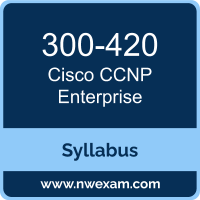 A great way to start the Cisco Certified Specialist Enterprise Design (ENSLD) preparation is to begin by properly appreciating the role that syllabus and study guide play in the Cisco 300-420 certification exam. This study guide is an instrument to get you on the same page with Cisco and understand the nature of the Cisco CCNP Enterprise exam.
A great way to start the Cisco Certified Specialist Enterprise Design (ENSLD) preparation is to begin by properly appreciating the role that syllabus and study guide play in the Cisco 300-420 certification exam. This study guide is an instrument to get you on the same page with Cisco and understand the nature of the Cisco CCNP Enterprise exam.
Our team of experts has composed this Cisco 300-420 exam preparation guide to provide the overview about Cisco Designing Cisco Enterprise Networks exam, study material, sample questions, practice exam and ways to interpret the exam objectives to help you assess your readiness for the Cisco ENSLD exam by identifying prerequisite areas of knowledge. We recommend you to refer the simulation questions and practice test listed in this guide to determine what type of questions will be asked and the level of difficulty that could be tested in the Cisco CCNP Enterprise certification exam.
Cisco 300-420 Exam Overview:
| Exam Name | Designing Cisco Enterprise Networks |
| Exam Number | 300-420 ENSLD |
| Exam Price | $300 USD |
| Duration | 90 minutes |
| Number of Questions | 55-65 |
| Passing Score | Variable (750-850 / 1000 Approx.) |
| Recommended Training |
Designing Cisco Enterprise Networks | ENSLD Designing Cisco Enterprise Networks 2.0 Designing Cisco Enterprise Networks (ENSLD) v2.0 |
| Exam Registration | PEARSON VUE |
| Sample Questions | Cisco 300-420 Sample Questions |
| Practice Exam | Cisco Certified Specialist Enterprise Design Practice Test |
Cisco 300-420 Exam Topics:
| Section | Weight | Objectives |
|---|---|---|
| Advanced Addressing and Routing Solutions | 25% |
- Create structured addressing plans for IPv4 and IPv6 - Create stable, secure, and scalable routing designs for IS-IS - Create stable, secure, and scalable routing designs for EIGRP - Create stable, secure, and scalable routing designs for OSPF - Create stable, secure, and scalable routing designs for BGP
- Determine IPv6 migration strategies
|
| Advanced Enterprise Campus Networks | 25% |
- Design campus networks for high availability
- Design campus Layer 2 infrastructures
- Design multicampus Layer 3 infrastructures
- Describe SD-Access Architecture (underlay, overlay, control and data plane, automation, wireless, and security) |
| WAN for Enterprise Networks | 20% |
- Describe WAN connectivity options for on-premises, hybrid, and cloud solutions
- Design site-to-site VPN for on-premises, hybrid, and cloud solutions
- Design high availability for enterprise WAN for on-premises, hybrid, and cloud solutions
- Describe Cisco SD-WAN architecture (orchestration plane, management plane, control plane, data plane, on-boarding and provisioning, security) |
| Network Services | 20% |
- Select QoS strategies to meet customer requirements (DiffServ, IntServ) - Design end-to-end QoS policies
- Design network management techniques
- Describe multicast routing concepts (source trees, shared trees, RPF, rendezvous points) |
| Automation and Artificial Intelligence | 10% |
- Differentiate between IETF, OpenConfig, and Cisco YANG models - Differentiate between NETCONF and RESTCONF - Describe the impact of model-driven telemetry on the network
- Describe GRPC and GNMI |
Cisco ENSLD Exam Description:
Designing Cisco Enterprise Networks v1.1 (ENSLD 300-420) is a 90-minute exam associated with the CCNP Enterprise Certification. This exam certifies a candidate's knowledge of enterprise design including advanced addressing and routing solutions, advanced enterprise campus networks, WAN, security services, network services, and SDA. The course, Designing Cisco Enterprise Networks, helps candidates to prepare for this exam.
